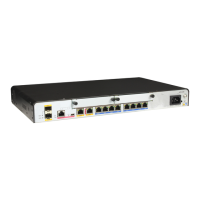l Configuration file of LSRD
#
sysname LSRD
#
mpls lsr-id 4.4.4.4
mpls
#
mpls ldp
longest-match
#
mpls ldp remote-peer lsra
remote-ip 1.1.1.1
undo remote-ip pwe3
remote-ip auto-dod-request
#
interface GigabitEthernet1/0/0
ip address 10.1.3.2 255.255.255.0
mpls
mpls ldp
mpls ldp advertisement dod
#
interface LoopBack0
ip address 4.4.4.4 255.255.255.255
#
ip route-static 0.0.0.0 0.0.0.0 10.1.3.1
#
return
2.13.5 Example for Configuring an Inbound LDP Policy
This section describes how to configure an inbound LDP policy, including the operation of
enabling MPLS and MPLS LDP globally.
Networking Requirements
MPLS LDP is configured on the network shown in Figure 2-10. LSRD is a DSLAM functioning
as a low-performance access device. By default, LSRD receives label mapping messages from
all peers and then uses the routing information in these messages to establish a large number of
LSPs. As a result, memory on LSRD is overused and LSRD is overburdened. An inbound LDP
policy needs to be configured on LSRD to allow LSRD to receive label mapping messages for
routes to only LSRC and to establish LSPs to LSRC, saving resources.
Figure 2-10 Networking diagram of an inbound LDP policy
LSRB
Eth1/0/0
10.1.1.1/24
Eth1/0/0
10.1.1.2/24
LSRA LSRC
Eth2/0/0
10.1.2.1/24
Eth1/0/0
10.1.2.2/24
Loopback1
1.1.1.9/32
Loopback1
2.2.2.9/32
Loopback1
3.3.3.9/32
LSRD
Loopback1
4.4.4.9/32
Eht1/0/0
10.1.3.1/24
Eth1/0/1
10.1.3.2/24
Huawei AR1200 Series Enterprise Routers
Configuration Guide - MPLS 2 MPLS LDP Configuration
Issue 01 (2011-12-30) Huawei Proprietary and Confidential
Copyright © Huawei Technologies Co., Ltd.
90

